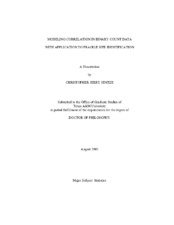| dc.contributor.advisor | Dahm, P. Fred | |
| dc.creator | Hintze, Christopher Jerry | |
| dc.date.accessioned | 2006-10-30T23:28:05Z | |
| dc.date.available | 2006-10-30T23:28:05Z | |
| dc.date.created | 2005-08 | |
| dc.date.issued | 2006-10-30 | |
| dc.identifier.uri | https://hdl.handle.net/1969.1/4278 | |
| dc.description.abstract | Available fragile site identification software packages (FSM and FSM3) assume
that all chromosomal breaks occur independently. However, under a Mendelian model of
inheritance, homozygosity at fragile loci implies pairwise correlation between
homologous sites. We construct correlation models for chromosomal breakage data in
situations where either partitioned break count totals (per-site single-break and doublebreak
totals) are known or only overall break count totals are known. We derive a
likelihood ratio test and Neyman’s C( α) test for correlation between homologs when
partitioned break count totals are known and outline a likelihood ratio test for correlation
using only break count totals. Our simulation studies indicate that the C( α) test using
partitioned break count totals outperforms the other two tests for correlation in terms of
both power and level. These studies further suggest that the power for detecting
correlation is low when only break count totals are reported. Results of the C( α) test for
correlation applied to chromosomal breakage data from 14 human subjects indicate that
detection of correlation between homologous fragile sites is problematic due to
sparseness of breakage data. Simulation studies of the FSM and FSM3 algorithms using
parameter values typical for fragile site data demonstrate that neither algorithm is
significantly affected by fragile site correlation. Comparison of simulated fragile site
misclassification rates in the presence of zero-breakage data supports previous studies
(Olmsted 1999) that suggested FSM has lower false-negative rates and FSM3 has lower
false-positive rates. | en |
| dc.format.extent | 790936 bytes | en |
| dc.format.medium | electronic | en |
| dc.format.mimetype | application/pdf | |
| dc.language.iso | en_US | |
| dc.publisher | Texas A&M University | |
| dc.subject | Fragile Site | en |
| dc.subject | Correlation | en |
| dc.subject | Binary Variables | en |
| dc.subject | Correlated Bernoulli Trials | en |
| dc.title | Modeling correlation in binary count data with application to fragile site identification | en |
| dc.type | Book | en |
| dc.type | Thesis | en |
| thesis.degree.department | Statistics | en |
| thesis.degree.discipline | Statistics | en |
| thesis.degree.grantor | Texas A&M University | en |
| thesis.degree.name | Doctor of Philosophy | en |
| thesis.degree.level | Doctoral | en |
| dc.contributor.committeeMember | Greenbaum, Ira F. | |
| dc.contributor.committeeMember | Schmiediche, Henrik | |
| dc.contributor.committeeMember | Speed, F. Michael | |
| dc.type.genre | Electronic Dissertation | en |
| dc.type.material | text | en |
| dc.format.digitalOrigin | born digital | en |


